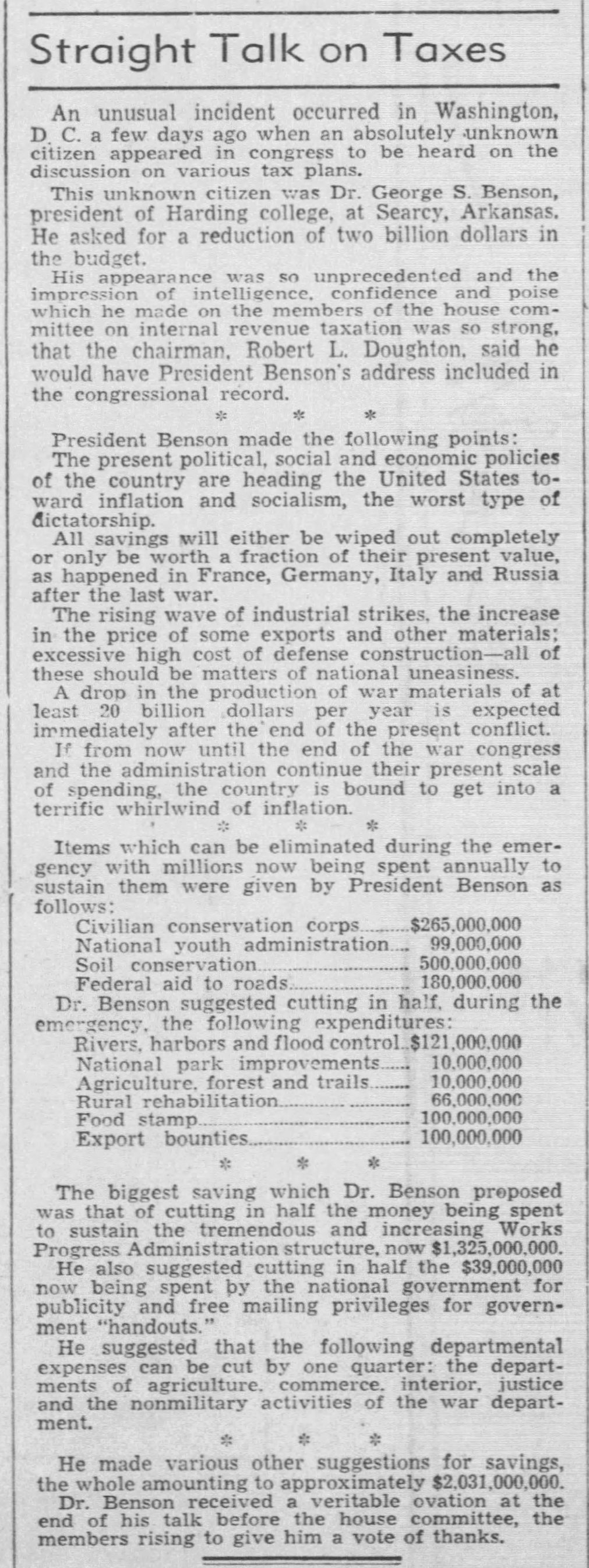Dr. George Stuart Benson
1898-1991
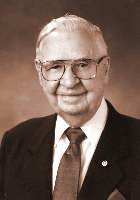
Long Time Evangelist
President Emeritus Of Harding University
Great Promoter And Advocate Of Christian Education
![]()
George S. Benson
{EDITOR'S NOTE: George Stuart Benson died Dec. 15. 1991, at age 93. At the time this article was submitted, he was gravely ill in a nursing home in Searcy, Ark.}
Throughout his active adult years, George Benson was first and foremost an evangelist, a missionary and a teacher of the Bible. For many years, he participated in governmental affairs of this nation. He was also internationally recognized as lm opponent of communism. A survey of his life helps to explain these various interests.
When Benson and his bride, Sally Ellis Hockaday Benson arrived in China in the early fall of 1925, they found themselves in the middle of a war. Chinese Communists led by Russian Communists were trying to lake control of China. The old war lords of China opposed them. The Communists were winning. They were supported by the Chinese Nationalist Party (the Kuomintang) led by Chiang Kai-shek.
The Bensons knew little about China except that it was a vast country that needed the Gospel of Christ. They went 500 miles into the interior to begin their work. After several months of diligent language study and personal work, however. They learned that the Communists would not permit them to stay. In fact the mayor of the village, their friend came to them by night and entreated them to get out as soon as they could. With much difficulty, they managed to make their way to the British crown colony of Hong Kong and safety.
After working to establish churches in Hong Kong and the Philippine Islands for two and one-half years. They were able to return to mainland China. Chiang Kai-shek had turned against the Communists. He drove them out of their centers of power, shipped their Russian advisers back to the Soviet Union and invited missionaries to return.
So in January 1929 the Bensons moved to Canton. For the next several years, with an interlude for study in America, they worked there with fellow missionaries who came from America to serve in a great field. They built Canton Bible School and they built the church.
In the spring of 1936, the trustees of Harding University in Searcy. Ark. invited Benson to come home and assume the presidency of Harding. After much soul-searching and conferring with fellow workers, the Bensons packed their belongings and, with their two daughters, both of whom had been born in Hong Kong, returned to America. Arriving in Searcy, they found themselves in another kind of war - a battle to save a school.
Harding was on the verge of bankruptcy. The trustees had moved the college from Morrilton to Searcy just two years before Benson's arrival. The transfer involved the purchase of an entire campus from a college that had operated in Searcy for many years but which had moved to another city. A rather large debt (for the 1930s) was incurred. It had not been reduced since the move.
Benson saw the need for more money than Harding had ever raised. For various reasons, he saw that such funds could not be secured from church members. So, he turned to the business world to seek support for his college. He began by inviting business leaders to speak on the Harding campus. He thought the speakers would be good for the students and the students would be good for the speakers.
An early speaker was Sterling Morton of the Morton Salt Company of Chicago. He was so impressed by the "small college in a small town, in a small state," that over a period of years he gave several hundreds of thousands of dollars to it. Others did likewise.
Benson's big break came on May 15, 1941. He appeared before the Ways and Means Committee of the U.S. House of Representatives. The committee was holding public hearings on a proposed fax bill to help finance the defense effort in World War II.
Committee members were tired after 15 days of hearings. They obviously did not expect much from the small-town college president. The committee chairman instructed him to keep his statement short.
He made a speech they would never forget. It made national headlines. Some newspapers printed the entire text. The Chicago Journal of Commerce offered reprints for a dollar per 100 and received orders for 300,000 copies. Banks, insurance companies, railroad companies and others reprinted the speech until some 2,000,000 copies were in circulation.
In that speech, Benson told members of the committee that they should not think of raising taxes until they had eliminated all unnecessary expenses of the government. He did not deal in generalities. He specified agencies and projects that could be abolished or cut down to size.
The Civilian Conservation Corps was one. He pointed out that it had been created during the Depression to provide jobs, but with defense plants springing up over the country and with navy yards advertising for workers, there was no longer any need for make work projects. The same was true with the National Youth Administration and the Works Progress Administration.
As he continued ticking off savings that could be made, he gained the attention of the members of that committee. At the conclusion of the speech, committee members violated their own standing rule of never applauding a speaker, they gave him a rousing ovation. He did not succeed in keeping taxes down, because as the war came on, additional billions were required. But at least he struck a blow for keeping them lower than they might have been.
Within two years, the WPA, the CCC and the NYA were all gone. Other savings he had recommended were put into effect. The Tax Foundation of America honored him at a banquet at the Waldorf Astoria Hotel in New York on Dec. 3, 1941. The president of the foundation praised him as being the most effective speaker and influence in the nation in achieving results for sane governmental economy.
Invitations to speak I started coming in from all over the nation. He began to spend most of his time on the road. He became personally acquainted with and was welcomed into the offices of board chairmen and presidents of major corporations all over America.
Media coverage became extensive. The New York Times and the Chicago Tribune ran stories about Benson and Harding. In fact, newspapers from various parts of the nation began regular coverage of Benson speeches and Harding activities. The Saturday Evening Post ran a feature titled "Arkansas Crusader." National Geographic featured Benson and Harding in a story, "Arkansas Rolls Up Its Sleeves." Reader's Digest carried a short article, "If I Were a Communist" by Benson. An editorial in the Oklahoma City Times stated, "He has been allotted more newspaper space, given more addresses and radio time and has attracted larger audiences than any other living American and he has battled sturdily to jar this country back into a sense of fundamental realities."
Although most of his speeches were not fundraising efforts, donations began arriving on campus. Debts were paid and, as soon as the war was over and materials could be obtained, a continuing building program was begun. The student body grew rapidly and the faculty grew along with it - in quality as well as in quantity. A permanent endowment fund got underway.
Freedom Forums and the National Education Program were organized and began reaching out over the nation. As World War II ended and the "Cold War" with communism got under way, these enterprises became known worldwide for their attacks on communism. This brought commendation to Benson and Harding and frequently aroused criticism. Harding continued to grow.
In addition to building Harding up from a small, unaccredited, nearly bankrupt institution to a strong and respected institution of Christian higher education. Benson took time along the way to serve as chancellor of Oklahoma Christian College, now Oklahoma Christian University of Science and Arts. In that capacity, he was indispensable in helping get the name changed from Central Christian College to Oklahoma Christian College, in making possible the move from Bartlesville to Oklahoma City and in getting support from business leaders of Oklahoma as well as of church leaders throughout the state and elsewhere. There has, in all probability, never been another college president who was willing to persuade a number of leading supporters of his own institution to channel their gifts and students to a new Christian college in an adjoining state. Benson did that for Oklahoma Christian.
He was always willing to help other schools. In his boundless optimism for Christian education, he was convinced there was enough money to go around.
After retiring from the presidency of Harding in 1965 and the chancellorship of Oklahoma in 1967, he threw his energies into building a network of Christian schools in Zambia. Today, there are seven campuses and 2,400 students in those schools. Under the present leadership of Dr. Kelly Hamby and a good board of trustees, prospects are excellent for continued growth.
On Dec. 17, 1981, the beloved Sally Ellis Benson died. They had been married 56 years. Within a few months. Benson found the loneliness of their Searcy home more than he wished to experience. So at the age of 84, he moved into a men's dormitory. This created quite a story on the campus - an 84-year-old dorm resident. He announced from the beginning that he did not intend to run the dormitory or try to police the residence He said he did not hear any noise. He was a model resident."
On Feb. 22, 1983, he married Marguerite O'Banion, who had served as his efficient secretary for 40 years or so. She had been just the right choice for him since that time and he has been for her.
Benson has been a builder throughout life. He was a prime mover in developing two university campuses and has helped with numerous others. But far more important than buildings of concrete and steel would be the influence he has had upon minds and hearts of people, young and old.Daniel Webster expressed it well a century and a half ago:
"If we work upon marble, it will perish. If we work upon brass, time will efface it. If we rear temples, they will crumble to dust. But if we work upon men's immortal minds, if we imbue them with high principles, with the just fear of God and love of their fellow men, we engrave on those tablets something which no time; can efface, and which will I brighten and brighten to all eternity."
(Editor's Note: John C. Stevens is president emeritus and chancellor emeritus of Abilene Christian University. Station ACU, Abilene, TX 79699. Harding University has published a book by John C. Stevens, Before Any Were Willing - The Story of George S. Benson. The full story will inspire and stimulate us all to greater dedication and effective service for the Lord, the church and our country.)
-Gospel Advocate, 1992, pages 42,43
![]()
1941 Speech By Dr. George S. Benson
Before The Ways and Means Committee of the U.S. House of Representatives
May 15, 1941
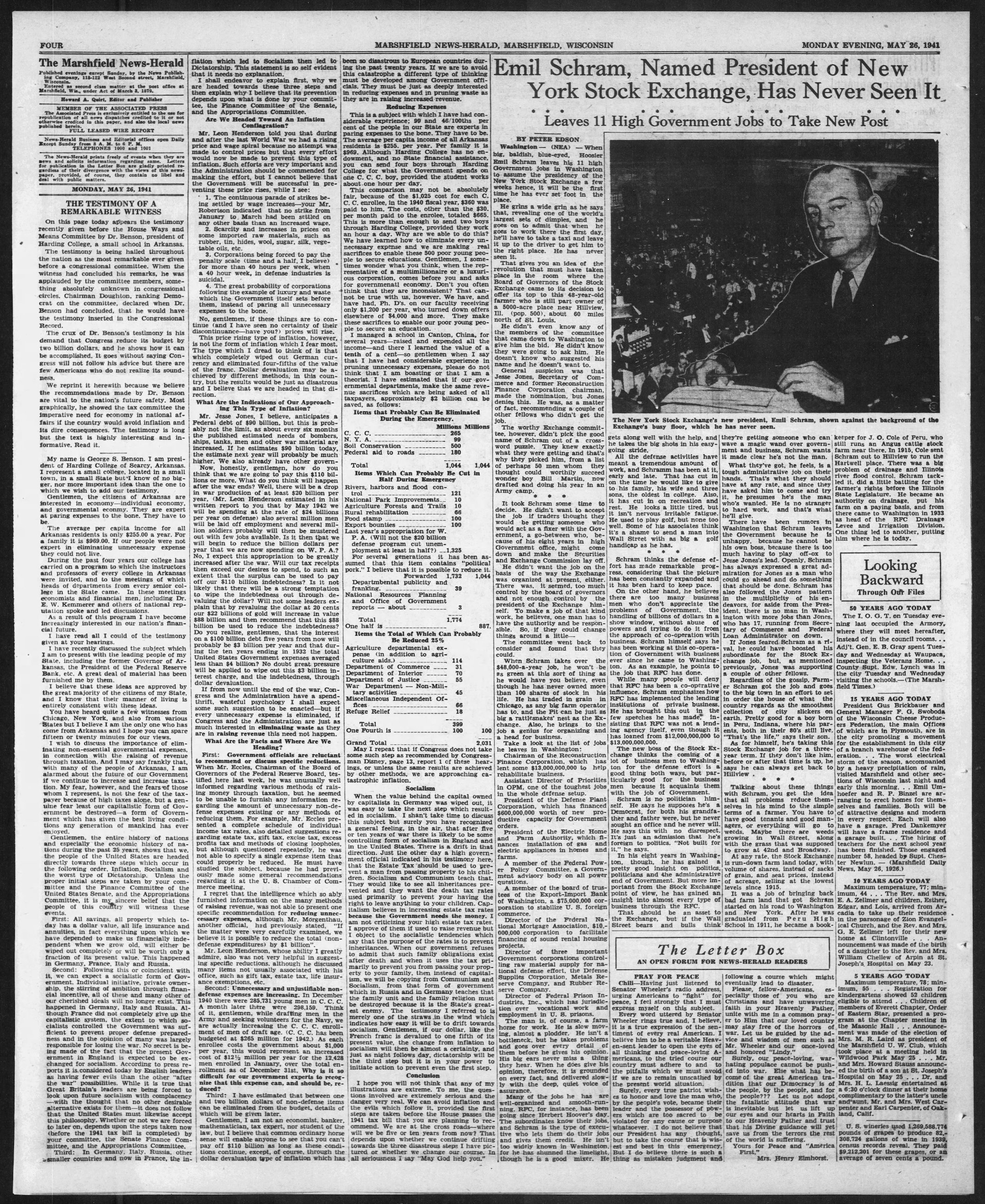
Marshfield News Herald, Marshfield, Wisconsin
Monday, May 26, 1941, p.4
Click on photo to zoom in
![]()
One of the Hundreds Of Reports Across The Country
Noting The 1941 Speech
Honolulu Star, Honolulu, Hawaii
Monday, June 30, 1941, page 8
Click on photo to zoom in
![]()
George Benson (93) Dies
SEARCY, Ark. - George Stuart Benson; 93, the president of Harding University from 1936-65, died December 15, in Searcy. He had devoted his life to Christian Education, particularly in the development of Harding University, Oklahoma Christian University, and George Benson Junior College in Zambia.
Brother Benson was extolled as a "man of great vision" committed to faith in God, Constitutional government and private ownership of property. He was an elder at the College Church of Christ and President Emeritus of Harding. Born in Dewie County, Oklahoma in 1898, he had attended Harper College and Oklahoma A&M before enrolling at Harding. He had been honored by numerous organizations, but one of which he was most grateful was election to the Oklahoma Hall of Fame.
A member of the first graduating class of Harding in 1925, a year in which he taught classes and worked as a coach, he married Sallie Ellis Hockaday. The two left almost immediately for China, working as missionaries until 1936 when he was asked to become president. Harding had a decided indebtedness which he worked hard to resolve, and by 1954 had achieved accreditation by the North Central Association of Schools and Colleges. During his years as president, hemanaged the construction of numerous major buildings and programs.
Sallie Benson died in 1981.
In 1983, he married Marguerite O'Banion, who survives. He is also survived by two daughters, Lois Benson McEuen of Little Rock and Ruth Benson Crowder of Macomb, Ill.; a sister, Bertha Hayes of Canton, Okla.; nine grandchildren and 16 great grandchildren.
About 2000 attended funeral services in Benson Auditorium on the Harding campus December 17. Participating in the service were Virgile Lawyer, Neal Pryor,J.D. Bales, Lott Tucker, Terry Johnson, David Burks, John Stevens, Ray Muncy, Joe Hacker and Rayton Sianjina. Singing was under the direction of Arthur Shearin and Kenneth Davis, Jr.
Burial was in Oak Grove Cemetery by Roller-Daniel Funeral Service of Searcy. The family requested memorials be made to the Zambian Mission Fund or the George S. Benson Professorship of Private Enterprise Education at Harding University.
-From The Magnolia Messenger of January 1992, Al Franks, Editor, Also, World Evangelist, Feb. 1992, p.5
![]()
George S. Benson Dies at 93
George Stuart Benson. 93. president of Harding University from 1936-65. died Dec. 15, 1991. in Searcy.
He was known for his devotion to Christian education. particularly in the I development of Harding University, Oklahoma Christian University and George Benson Junior College in Zambia. He also worked to promote Namwianga Christian School in Zambia. He was an elder at the College Church of Christ and president emeritus of Harding. He was a member of the Oklahoma Hall of Fame. Benson graduated with Harding's first graduating class in 1925. He married Sallie Ellis Hockaday that year. and they left almost immediately for China, where they worked as missionaries until 1936 when Benson was asked to become Harding's new president. During his tenure as president. Harding achieved national accreditation, and several building programs were implemented. Sallie Benson died in 1981. In 1983 he married Marguerite O'Banion, who survives. Also surviving are daughters Lois Benson McEuen of Little Rock. Ark., and Ruth Benson Crowder of Macomb. Ill.; a sister, Bertha Hayes of Canton, Okla.; nine grandchildren and 16 great-grandchildren. About 2,000 people attended funeral services in Benson Auditorium on the Harding campus Dec. 17. Burial was in Oak Grove Cemetery by Roller-Daniel Funeral Service of Searcy. The family requested memorials be made to the Zambian Mission Fund or the George S. Benson Professorship of Private Enterprise Education at Harding University.-Gospel Advocate, January, 1992, page 31.
![]()
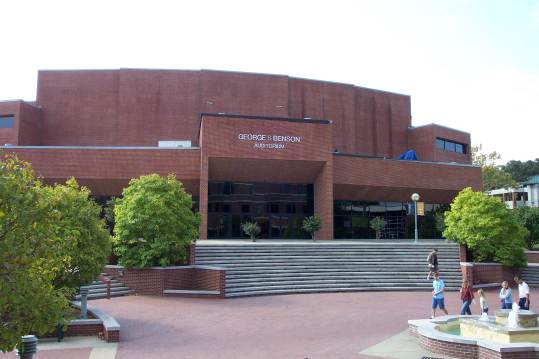
George S. Benson Auditorium, On
Harding University Campus
The Largest Public Facility In Arkansas
![]()
Directions To The Grave Of George S. Benson
George S. Benson is buried in the Oak Grove Cemetery in Searcy, Arkansas. Oak Grove is the oldest cemetery in Searcy and is located in the north central part, near downtown. If looking at a map, the location is on E. Moore. If traveling from Main Street turn north on N. Horton and it will dead end into E. Moore with the cemetery straight ahead. If entering the west entrance of the cemetery stop immediately upon entering, and look to the left. Under the trees at the front corner of the cemetery is the Benson monument. See Cemetery Map Here!
GPS Coordinates
N35º 15' 202" x WO 91º 43' 957"
or D.d 35.253364408965226,-91.73257023096085
Facing East
![]()
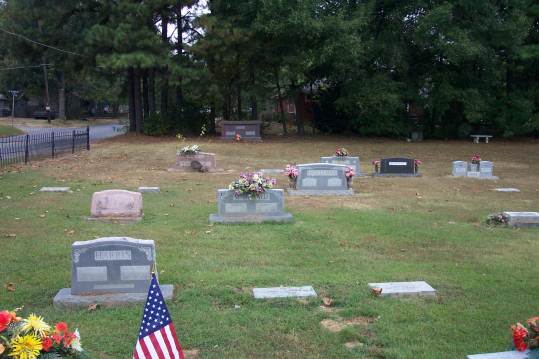
Benson Monument In Distance Under Trees
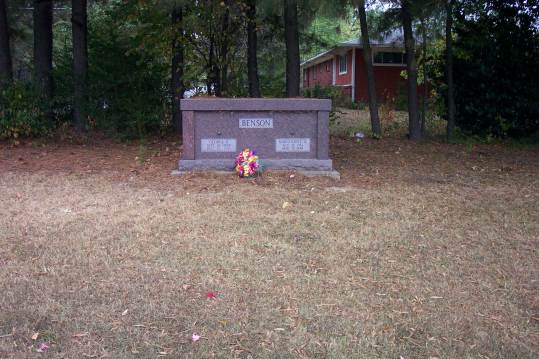
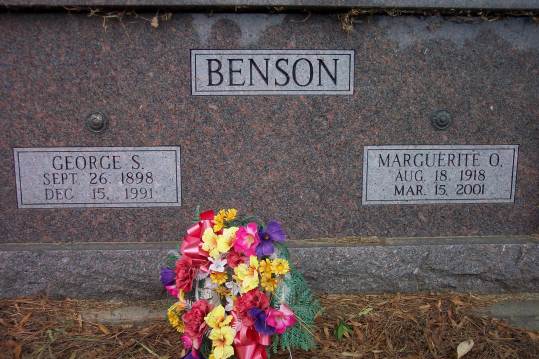
George S.
Sept. 26, 1898
Dec. 15, 1991
Marguerite O.
Aug. 18, 1918
Mar. 15, 2001
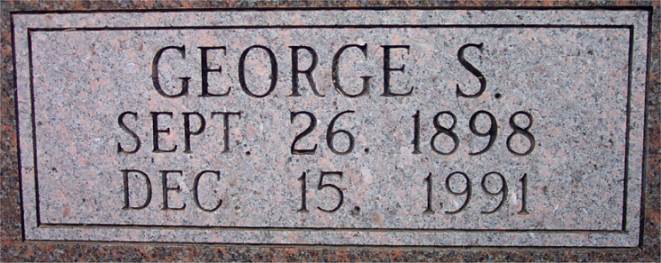
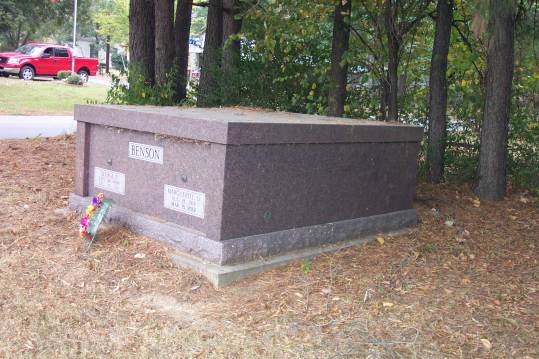
![]()
Lectures On Video By George S. Benson
See A Sculpture Of George S. Benson
![]()
1969 Interview with Dr. George S. Benson mp3
Interviewer Clifton Ganus, Jr.
![]()
